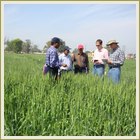| |
 |
Subscribe to the
Research Digest, or Read Online |
|
| |
|
|
Trends in Environmental Education
Environmental education can engage people of all ages and walks of life to sustain the natural systems people depend on. This process of informing decisions - at a personal, local and global scale - about environmental sustainability is the focus of a recent study co-authored by Stanford Woods Institute Center Fellow Nicole Ardoin. Drawing on current research as well as interviews and "conversational cafés" with environmental educators, communicators, students and researchers, Ardoin and her colleagues write about the importance of collective, community learning that links environmental quality and human well-being. Their findings underscore the need for more study of urban and diverse populations, and influences from digital and social media. They also note a recurring concern - the "inaccessibility of research findings and the difficulty of translating research into practice." The Stanford Woods Institute is working to address this issue with our new Research Digest, which provides a quarterly overview of new findings by Stanford's environmental researchers. We invite you to subscribe to the Digest, and read on for more insights from Ardoin and other Woods fellows, affiliated faculty and fellows with our Leopold Leadership Program.
"An Exploration of Future Trends in Environmental Education Research," Environmental Education Research, Aug. 24, 2012 |
|
|
| |
| |
 |
 |
Snowpack Decline May Threaten Water for Billions
Snowpack, an essential source of drinking water and agricultural irrigation for billions of people, could shrink significantly within the next 30 years, according to a study led by Stanford Woods Institute Center Fellow Noah Diffenbaugh. The study forecasts climate change's effect on Northern Hemisphere snowpack through the 21st century, with particularly bad news for the Western U.S. and California's massive farm industry.
Read More ...
"Response of snow-dependent hydrologic extremes to continued global warming," Nature Climate Change, Nov. 11, 2012 |
 |
Oil Palm Plantations Displacing Tropical Forests
Expanding production of palm oil, a common ingredient in processed foods, soaps and personal care products, is driving rainforest destruction and releasing massive amounts of excess CO2 into the atmosphere, according to a new study co-authored by Stanford Woods Institute Senior Fellow Lisa Curran. The study shows that deforestation for the development of oil palm plantations in Indonesian Borneo is becoming a globally significant source of the CO2 emissions fueling global climate change. Plantation expansion is projected to contribute more than 558 million metric tons of carbon dioxide to the atmosphere in 2020 - an amount greater than all of Canada's current fossil fuel emissions.
Read More ...
"Carbon emissions from forest conversion by Kalimantan oil palm plantations," Nature Climate Change, Oct. 7, 2012 |
 |
Tropical Rain May Have Formed Utah's Great Salt Lake
New research by scientists including Stanford Woods Institute Center Fellow Noah Diffenbaugh suggests the Great Basin - stretching across the North American West from southern Oregon down to Reno and across dry, desert plains to Salt Lake City - was flooded during the last glacial period by storms moving up from the tropics. The study could answer the question of how enormous lakes came to cover the deserts of the American Southwest between 14,000 and 20,000 years ago and why those lakes dried out at the end of the glacial period.
Read More...
"Out of the Tropics: The Pacific, Great Basin Lakes, and Late Pleistocene Water Cycle in the Western United States," Science, Sept. 28, 2012 |
 |
Climate Science as Culture War
The public debate around climate change is no longer about science. It's about values, culture and ideology, Leopold Leadership Program Fellow Andrew Hoffman argues in a recent article based on his research. In order to reach social consensus on climate change, we must look at the debate through a social science lens and take into account that people perceive the issue according to their prior ideological preferences, personal experience and values, he writes. Hoffman explores ways of looking at the processes by which people receive and understand the science of global warming, possible paths for the debate to follow and techniques to drive it toward broader consensus. Hoffman wrote a related article for the journal Solutions in July 2012.
"Climate science as culture war," Stanford Social Innovation Review, Fall 2012 |
| |
More information about Stanford Woods Institute climate research |
| |
 |
 |
Finding the Cultural and Social Value of Ecosystem Services
Most research on ecosystem services - the societal value of land and water - emphasizes valuation of material contributions to human well-being and pays little attention to cultural and nonmaterial values. In a recent paper, researchers including Mary Ruckelshaus, Stanford Woods Institute consulting professor and Natural Capital Project managing director, propose a framework for assessing ecosystem services' less tangible benefits.
The framework aims to facilitate fuller and more socially acceptable integrations of ecosystem services information into planning and management.
Photo Credit: NOAA
"Where Are Cultural and Social in Ecosystem Services? A Framework for Constructive Engagement," BioScience, August 2012. |
 |
Taking the Pulse of Earth's Life-Support Systems
To achieve sustainability, we need to be able to monitor our planet's health and respond accordingly. A study led by Heather Tallis, lead scientist at the Natural Capital Project, and co-authored by researchers including Stanford Woods Institute Senior Fellow Harold Mooney, proposes a way to monitor ecosystem services on a global scale. The framework integrates national statistics, numerical models, remote sensing and in situ measurements to regularly track changes in ecosystem services across the globe. It includes a tangible plan to coordinate, standardize and broaden access to existing databases that track and monitor the delivery of ecosystem services. If implemented, it would inform local, regional and global research, and decisions related to the environment and society.
Read More...
"A Global System for Monitoring Ecosystem Service Change," BioScience, November 2012 |
 |
When Trees Don't Equal Carbon Sequestration
An increase in tree cover does not necessarily lead to an increased provision of ecosystem services such as carbon sequestration, according to a new study by researchers including Stanford Woods Institute Senior Fellow Eric Lambin. The study looks at the merits of economic incentives for reforestation and afforestation projects to sequester carbon positive impacts for biodiversity conservation. It explores the relationships between an increase in tree cover area and changes in forest carbon storage and the potential of a landscape to provide habitat for native floristic biodiversity.
Photo Credit: Cruiser
"Trade-Offs Between Tree Cover, Carbon Storage and Floristic Biodiversity in Reforesting Landscapes," Landscape Ecology, October 2012 |
 |
High-Value Agricultural Commodities and Poverty Alleviation
Does niche trade of expensive agricultural products contribute to poverty alleviation? A new study co-authored by Stanford Woods Institute Senior Fellow Eric Lambin and Yann le Polain de Waroux, a newly appointed Woods postdoctoral researcher, considers the question with an eye toward argan oil, a plant oil used in beauty products, which sells for more than $400 per liter. The study finds that argan oil commercialization has played a relatively minor role in household budgets and asset accumulation. This shows the importance of a livelihood approach in contextualizing commodity
chains and the influence of agro-ecological conditions, resource scarcity, resource ownership regime and value chain characteristics on niche commodity marketing's poverty alleviation effect.
"Niche Commodities and Rural Poverty Alleviation: Contextualizing the Contribution of Argan Oil to Rural Livelihoods in Morocco," Annals of the Association of American Geographers, Oct. 15, 2012 |
| |
More information about Stanford Woods Institute ecosystem services research |
| |
 |
 |
Charting a Course to Sustainable Aquaculture
Aquaculture is the fastest-growing animal food production sector and will soon supply more than half of the world's seafood. A recent study by Rosamond Naylor, Stanford Woods Institute senior fellow and Center on Food Security and the Environment director, and Stanford Ph.D. student Dane Klinger, explores potential solutions to the industry's range of resource and environmental problems. Naylor and Klinger examine solutions such as novel culture systems; alternative feed strategies; and species choices by stage of adoption, benefits, costs and constraints. The study also considers promising technologies and policies that could provide incentives for innovation and environmental improvement.
"Searching for Solutions in Aquaculture: Charting a Sustainable Course," Annual Reviews Environment and Resources, October 2012 |
 |
Tracking Wheat Yields in India
Wheat is a staple crop throughout much of India, but in many areas it is commonly sown past the optimum yield window. A recent study by researchers including David Lobell, a Stanford Woods Institute center fellow and Center on Food Security and the Environment associate director, uses satellite measurements to estimate a decade's worth of sow dates in wheat-growing areas of India. The study finds, among other developments, that wheat was sown one week earlier by 2010 than it was at the beginning of the decade, a change that explains country-wide yield gains. It also predicts that yield benefits from sow date shifts will likely diminish in the next decade.
"Satellite detection of earlier wheat sowing in India and implications for yield trends," Agricultural Systems, Oct. 22, 2012 |
 |
Assessing Biofuels' Global Impacts
Policies promoting ethanol and biodiesel production and use in the U.S., Europe and other parts of the world since the mid-2000s have had profound and largely unintended consequences on global food prices, agricultural land values, land acquisition and food security in developing countries. They have also created regional opportunities in the form of agricultural investments, crop yield growth and prosperous farm economies. A paper by Rosamond Naylor, Stanford Woods Institute senior fellow and Center on Food Security and the Environment director, reviews the main policy initiatives behind the 21st century biofuels boom, describes how these policies influence food price levels and stability in international and national markets, and suggests themes to inform the debate over crop-based biofuels. The paper is part of a forthcoming volume, Frontiers in Food Policy for Sub-Saharan Africa and South Asia, a product of FSE's Global Food Policy and Food Security symposium series.
Photo Credit: DOE/NREL
Read More...
"Biofuels, Rural Development, and the Changing Nature of Agricultural Demand," Center on Food Security and the Environment, August 2012 |
 |
Putting Brazil's Soybean Production in Context
Soybean production has become a significant force for economic development in Brazil. It has also received considerable attention from environmental and social nongovernmental organizations as a driver of deforestation and land consolidation. A study led by Rachael Garrett, a Ph.D. candidate in Stanford's Emmett Interdisciplinary Program in Environment and Resources, and co-authored by Stanford Woods Institute Senior Fellows Eric Lambin and Rosamond Naylor examines the influence of land tenure, land use policy, cooperatives and credit access on soy production in Brazil. Their findings suggest that soybean production and profitability will increase as supply chain infrastructure improves, and that no significant relationship exists between land tenure and planted area or land tenure and yields. The study also provides evidence that policies intending to spare land through yield improvements could actually lead to land expansion in the absence of strong land use regulations.
Photo Credit: DOE/NREL
"Land Institutions and Supply Chain Configurations as Determinants of Soybean Planted Area and Yields in Brazil," Land Use Policy, October 2012. |
| |
More information about Stanford Woods Institute food security research |
| |
 |
 |
Finding Common Threads in Global Water Crises
What does drought in Kansas have to do with underutilized groundwater in sub-Saharan Africa? Potentially a lot, according to a new study by researchers with the Global Freshwater Initiative, a program of the Stanford Woods Institute. The study is the first to systematically analyze and classify water crises around the world. It finds that water systems have a limited set of patterns or "syndromes" and have their root causes in just a few factors - a finding that challenges long-held views that freshwater issues require highly individualized solutions.
The study's authors include Woods Senior Fellows Steven Gorelick, Eric Lambin and Buzz Thompson, Woods-affiliated Professor Scott Rozelle and lead author Veena Srinivasan, a former Stanford postdoctoral scholar.
Read More...
"The nature and causes of the global water crisis: Syndromes from a meta-analysis of coupled human-water studies," Water Resources Research, Oct. 5, 2012 |
| |
More information about Stanford Woods Institute freshwater research |
| |
 |
 |
Large Predators Connect Ecosystems
Sharks and other large predators play an important role in connecting and potentially stabilizing different ecosystems, according to a new study by researchers including Stanford Woods Institute Senior Fellow Rob Dunbar, Woods-affiliated faculty member Fiorenza Micheli and Stanford graduate students Douglas McCauley and Hillary Young. The study, funded by an Environmental Venture Projects grant, investigates how these animals' mobility determines important ecosystem processes. Reef-frequenting sharks, for example, may feed mostly away from the reef, using resources from different habitats and creating important linkages among them. The findings contain important implications for the management of large-predator populations - threatened throughout the world - and the design of conservation measures.
Read More...
"Assessing the effects of large mobile predators on ecosystem connectivity," Ecological Applications, September 2012 |
 |
Researchers Wire Kelp Forests off California Coast
A technological initiative that started as a Stanford Woods Institute Environmental Venture Projects (EVP) initiative will provide the power and real-time data access scientists need to monitor the effects of climate change on California's delicate coastal ecosystems. The original EVP team included Woods Senior Fellow Stephen Monismith and Woods-affiliated faculty Fiorenza Micheli and Mark Denny. The current project is spearheaded by Center for Ocean Solutions researcher Brock Woodson. The Kelp Forest Array, which is located just offshore from Stanford's Hopkins Marine Station in Pacific Grove, will enable a wide variety of oceanographic instruments to deliver data
to researchers in real time via a broadband cable.
Read More...
|
 |
The State of Our Oceans
A new comprehensive assessment - the first of its kind - provides a valuable look at the state of the world's oceans and marine ecosystems. Stanford Woods Institute Senior Fellow Larry Crowder, the science director of the Center for Ocean Solutions, was part of an international team of scientists that conducted the Ocean Health Index. Overall, the global average score for countries was 60 out of 100, with
individual scores ranging from 36 to 86 and the U.S. scoring 63. Some countries, for example, are doing well with biodiversity issues, but not so well with food provision. Others are doing well with tourism, but poorly when it comes to protecting iconic species.
Read More...
"An index to assess the health and benefits of the global ocean," Nature, Aug. 15, 2012 |
 |
Sustainable Seafood: Healthy for People and Oceans
Sustainable seafood is good both for the ocean environment and human health. In the first analysis of its kind, Leopold Leadership Program Fellow Leah Gerber and other researchers brought together several types of sustainability rankings, along with species-specific health metrics including Omega-3 fatty acids and mercury content. The results are intended to help inform consumers about the health risks and benefits of different seafood choices, while addressing the ecological impacts of fishing and fish farming.
Photo Credit: avlxys
"Sustaining seafood for public health," Frontiers in Ecology and the Environment, November 2012 |
 |
New Insights on Mixing in the Ocean
Due to the many difficulties associated with measuring buoyancy flux directly in the field, parameterizations for the flux involving eddy diffusivities are commonly used. These parameterizations are often cast in terms of a mixing efficiency, which is often assumed to be a constant throughout the water column. A study by researchers including Stanford Woods Institute Senior Fellows Jeff Koseff and Stephen Monismith in the Gulf of Aqaba using three separate models to calculate the eddy diffusivities, and two different approaches for calculating mixing efficiency, has provided key new information about extant mixing efficiencies in the ocean, as well as the most accurate parameterizations of eddy diffusivity. These findings will be important to the development of more accurate models for predicting the mixing of scalars like oxygen, plankton and particulate matter in the ocean.
Photo Credit: SM14
"Comparison of Mixing Efficiency and Vertical Diffusivity Models From Temperature Microstructure," Journal of Geophysical Research, Aug. 29, 2012 |
 |
Making Tidal Connections
Elkhorn Slough is a shallow, tidally forced estuary that is directly connected to Monterey Bay. It is ebb dominated and, due to continued erosion, the tidal prism has tripled over the past 40 years. In a study co-authored by Stanford Woods Institute Senior Fellow Stephen Monismith, water level measurements at four locations are used to examine tidal and nontidal oscillations in the slough. The study finds that detailed hydrodynamic models are needed to provide a better understanding of how tidal harmonics are generated and preserved in the slough, and to
determine the origin of the natural oscillations in Monterey Bay.
Photo Credit: NOAA National Ocean Service
"Contrasting Seasonal and Fortnightly Variations in the Circulation of a Seasonally Inverse Estuary, Elkhorn Slough, California," Estuaries and Coasts, Sept. 6, 2012 |
 |
Rethinking Tidal Currents
A study by researchers including Stanford Woods Institute Senior Fellow Stephen Monismith examines the spatial and temporal variabilities of alongshore semi-diurnal tidal currents in the northern Gulf of Eilat/Aqaba. Observations of velocity measured by acoustic Doppler current profilers deployed in deep, offshore waters and in the shallow coastal zone found that semi-diurnal tidal currents occurred throughout the entire study (October to July) in both the deep and shallow velocity records. This finding differs from previous studies that observed the
disappearance of semi-diurnal tidal currents from January to May, suggesting that such a disappearance is not a predictable, recurring feature of tidal currents in the Gulf. The velocity records combined with monthly hydrographic data show that the persistence of the semi-diurnal tidal currents throughout the winter and spring likely resulted from shallow upper layer depths.
"Observations of Tidal Currents in the Northern Gulf of Eilat/Aqaba (Red Sea)," Journal of Marine Systems, October 2012 |
 |
Scientists Predict Major Shifts in Location of Pacific Ecosystems by 2100
Results of scientific modeling could help manage potentially significant commercial and conservation impacts of marine habitat shifts due to climate change, according to a new study led by Center for Ocean Solutions-affiliated researcher Elliott Hazen and co-authored by Stanford Woods Institute Senior Fellows Larry Crowder and Barbara Block. The study, published in the journal Nature Climate Change, examines the distribution of various open-ocean predators in the North Pacific and explores how that could change over the next 100 years as global ocean temperatures
increase and productivity levels shift. The researchers conclude that some critical ocean habitats could undergo significant changes in location, moving more than 1,000 km (600 miles) from where they are now.
Read More...
"Predicted habitat shifts of Pacific top predators in a changing climate," Nature Climate Change, Sept. 23, 2012 |
| |
More information about Stanford Woods Institute oceans research |
| |
 |
 |
Wind Could Meet Global Power Demand by 2030
Adapting a sophisticated climate model, researchers including Stanford Woods Institute Senior Fellow Mark Jacobson show in a new study that there is plenty of wind available to supply half to several times the world's total energy needs within the next two decades. The model - the most sophisticated of its kind available - calculates the theoretical maximum wind power potential on the planet, taking into account wind reduction by turbines. It contradicts an earlier study that claimed wind potential falls far short of the aggressive goal because each turbine
steals too much wind energy from other turbines.
Photo Credit: Alan Fryer
Read More...
"Saturation wind power potential and its implications for wind energy," Proceedings of the National Academy of Sciences, Sept. 25, 2012 |
 |
INOGO Study: Airport Effects on Southern Costa Rica
Researchers with the Stanford Woods Institute's INOGO program in southern Costa Rica are helping the region's stakeholders assess the pros and cons of building an international airport in a new case study (in Spanish) released in October. The $42 million airport project - supported by the government and planned in one of the country's most ecologically valuable regions - has been controversial in an area where ecotourism drives the local economy. The Osa-Golfito region's serpentine waterways and wetlands are home to 3
percent of the world's known biodiversity. A recognized Wetland of International Importance lies three miles from the proposed airport site. The report looks at various scenarios for building the airport and analyzes how they might affect development, jobs and the region's high-value, small-scale ecotourism model.
Read More...
|
| |
More information about Stanford Woods Institute sustainable development research |
| |
|
|
| |
Find Us on the Web
   |
|
The Stanford Woods Institute Research Digest is a quarterly report of findings by Woods fellows and affiliated faculty, as well as fellows with the Institute's Leopold Leadership Program. Current and past issues are online.
Contact us to subscribe or provide information about new and forthcoming research.
To learn more about the Stanford Woods Institute for the Environment, visit our website or email us.
Stanford Woods Institute for the Environment
Jerry Yang & Akiko Yamazaki Environment & Energy Building - MC 4205
473 Via Ortega
Stanford, CA 94305 |
|
|
|
